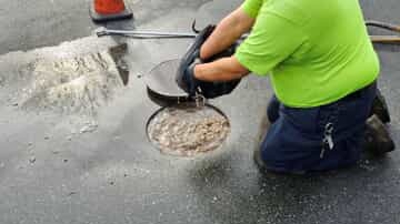How Grease Traps Work
In the bustling kitchen of a restaurant or any commercial kitchen or food production environment, managing waste efficiently and effectively is crucial to both operations and compliance with building codes and environmental regulations. Among the most critical systems for achieving this is the grease trap, a device designed to intercept fats, oils, and greases (FOG) before they enter the wastewater disposal system.
Grease traps have been essential to sanitation for commercial kitchens and food-serving establishments for decades. They work on a simple principle: grease traps slow down the flow of wastewater, allowing it to cool down. As it cools, the grease (which is lighter than water) separates and floats to the top, while solids settle at the bottom. Now largely free of FOGs, the water continues to the sewage system.
Inside Grease Traps
Inside grease traps, often called under-sink grease traps, are small devices installed close to the kitchen’s drainage system. They’re designed to service individual fixtures or a small group of fixtures. These grease traps connect directly to the plumbing of sinks or dishwashers and typically operate with lower flow rates than outside traps.
Pros:
- Ideal for smaller kitchens or establishments with limited space.
- Easier to access for cleaning and maintenance.
- Lower initial installation cost compared to outside grease traps.
Cons:
- Require more frequent cleaning due to smaller size.
- Might not be suitable for handling high volumes.
- Can emit unpleasant odors if not appropriately maintained.
Outside Grease Traps
Outside grease traps are large units typically installed underground. They are designed to handle wastewater from the entire kitchen or facility. Similar to their indoor counterparts, outside grease traps slow down wastewater to separate and trap grease. However, due to their larger size, they can handle a higher volume of wastewater and, consequently, more FOGs.
Pros:
- Suitable for commercial kitchens with high wastewater output.
- Require less frequent cleaning than inside grease traps.
- Keeps grease odors outside of the building.
Cons:
- Higher initial installation cost.
- Requires more space and significant excavation work for installation.
- Maintenance and cleaning can be more challenging due to size and location.
Maintenance Requirements for Indoor & Outdoor Grease Traps
Maintaining indoor grease traps involves regular inspections and cleanings to prevent clogs and ensure they operate efficiently. Depending on the volume of wastewater they process, these traps typically require cleaning every one to three months. Regular maintenance also includes checking for wear and tear and ensuring gaskets and seals are intact to prevent odors.
While less frequent, outdoor grease trap maintenance can be more labor-intensive due to their size and underground location. Professionals (like ours at Wind River Environmental) should inspect and pump out these traps at least once every three months or more often if they serve high-volume kitchens.
Signs your grease trap needs maintenance:
- Unpleasant odors emanating from the drains or grease traps area.
- Slow-draining sinks or backup problems in the kitchen.
- Visible grease accumulation around the trap or in adjacent plumbing.
- Increased pest activity around the kitchen or grease trap location.
- Frequent need to reset or deal with plumbing issues related to the sinks and dishwashers.
- Audible gurgling sounds from the plumbing system.
- An inspection reveals full or nearly full grease trap capacity.
New Installations: Do You Install Indoor or Outdoor Grease Traps?
When planning the installation of a grease trap for a new property, determining whether an indoor or outdoor model best suits your needs is a critical decision that hinges on several key factors. Understanding these considerations can help you make an informed choice that ensures your wastewater management system's efficiency, compliance, and cost-effectiveness.
When discussing which type of grease trap to install at your property, we will look at factors such as:
- The size and scale of your kitchen
- The expected volume of wastewater the trap must process
- Space availability in your building and on your property
- Local and federal regulations
Your grease trap is an essential investment for your commercial kitchen. Playing a critical role in wastewater management and environmental protection, your choice will significantly impact your day-to-day operations and the long-term health of your plumbing system. At Wind River Environmental, we can use our deep knowledge and extensive experience to help you make this decision.
Contact us online to discuss your grease trap installation, maintenance, or repair needs.






